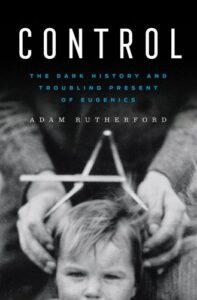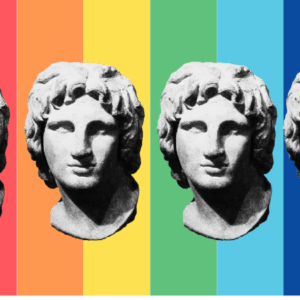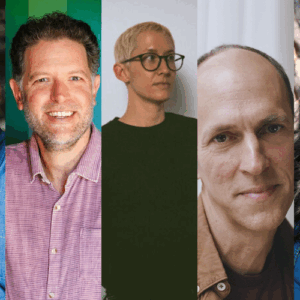
How Scientists’ Misguided Utopian Theories of Biological Selection Defined the 20th Century
Adam Rutherford on the Dark History and Troubling Legacy of Eugenics
For the whole of history, all cultures, all countries, all societies, have considered the principles of who can reproduce, who lives and who dies. Governments, society, biology, tradition and myriad other factors nudge and steer and compel people away from the freedom to reproduce with whomever they want. Biology and culture are inextricably entwined: each sculpts the other. For just over a century, we have referred to the deliberate crafting of society specifically by biological design with a word that for half of its existence has been regarded as desirable, and for the other half, poisonous: eugenics.
Eugenics is a project with a short history, but a long past. The oldest readers will have direct memories of the Second World War, and how governments tried to exert the most pernicious forces of control on their populations. Eugenics is perhaps most closely associated with the deranged acts of the Nazis and their evil attempts to exterminate not only millions of Jews, but also hundreds of thousands of people with physical disabilities or mental illnesses, or other characteristics such as homosexuality. They were collectively categorized as Lebensunwertes Leben—“lives unworthy of life.”
The escalation of Nazi Germany’s eugenics program to the Final Solution occurred in incremental steps, preceded by years of broader policies aimed at the general improvement of the German people under the guise of Rassenhygiene—“racial hygiene.” The toxicity of the idea of eugenics no doubt emerged from our collective discovery of the horrors of the Second World War, but state-sanctioned eugenics policies were also implemented in more than thirty countries, and some of these endure in the twenty-first century. They were espoused enthusiastically by the two great opposing powers of the postwar twentieth century—the communist Soviet Union and the capitalist United States. Eugenics has always enjoyed bipartisan support.
Eugenics is in many ways a defining idea of the twentieth century. It was enacted as policy by the most powerful and populous countries on Earth and fueled tyrannical regimes that tore the world apart with unprecedented vigor. Before that though, eugenics was a guiding light for the betterment of Western societies, viewed as normal and desirable by people across political divides, and forcefully championed by the most powerful men and women in society. Winston Churchill was a key driver of eugenics policy in the United Kingdom in the first two decades of the twentieth century, as was Theodore Roosevelt in the United States. Margaret Sanger, a pioneer of reproductive rights for women, advocated for eugenics policies, as did the scholar W. E. B. DuBois, as a potential mechanism for racial uplift for Black Americans.
Many playwrights, suffragists, philanthropists and philosophers, as well as more than a dozen Nobel Prize winners, embraced the ideas of eugenics as a force to change society, some with an almost religious fervor. The first part of this book is a history of an idea that hid in plain sight, from its roots in key philosophical texts of the classical world, in obscure and popular scientific books, and all the way into its genocidal realization in the twentieth century.
It’s difficult for us to comprehend, only a hundred years later, quite how ubiquitous this idea was in the early decades of the twentieth century.
It’s difficult for us to comprehend, only a hundred years later, quite how ubiquitous this idea was in the early decades of the twentieth century. But the evidence is right in front of us, baked into our culture and literature. Novels such as Aldous Huxley’s Brave New World or H. G. Wells’s The Island of Dr. Moreau are tales about genetic manipulation of human life, and the scientist and eugenicist Julian Huxley (brother of Aldous, friend of Wells) even advised on the 1932 film adaptation of Moreau, entitled Island of Lost Souls, for its scientific accuracy. Eugenics percolated through culture in less obvious and overtly fantastical ways too.
A seam running through The Great Gatsby is the then popular pseudoscientific fear about the replacement of ruling classes by less desirable members of American society—immigrants, African Americans, Irish, the poor—an idea that fueled much of the development of eugenics policies in the West, and persists among White supremacists to this day. “The Jews will not replace us!” screeched hysterical Nazis in Charlottesville, Virginia, in 2017, in full view of the world’s media, though it was never clear whether they imagined that they were to be replaced by Jews, or that Jews were orchestrating their replacement. Either way, the long-standing fantasy of the threat of population replacement is part of the elusive promise of eugenics—to exert control on who lives, who dies and whose people should be preserved.
The cultural ubiquity of eugenics even extends to our food: John Harvey Kellogg was the effective creator of the cornflake, and with those cereals reinvented breakfast for large parts of the world. Many readers will have eaten a dried cereal crop this morning (with a splash of milk enabled by your lactase persistence mutation) whose evolution began with Kellogg’s weird, obsessive desire to control libido with bland foods, and thus protect and preserve the precious bodily fluids of upstanding American men. Ridiculous though this sounds, Kellogg used his immense wealth to support and develop his obsessions. He became a champion of eugenics in the United States and, with that, a key driver of principles of racial hygiene that grew in parallel with the same policies in Nazi Germany. Until the Second World War, eugenics was a beacon of light for many countries striving to be better, healthier and stronger.
The long-standing fantasy of the threat of population replacement is part of the elusive promise of eugenics—to exert control on who lives, who dies and whose people should be preserved.
The second part of this book concerns where we are now. Population control policies that resemble eugenics are still enacted today. Toxic though the word may now be, the ideas underlying eugenics are not historical. They are our present. We live in a time where forced sterilization of women is ongoing in many nations, and where sex-selective abortion is rife in the two most populous countries on Earth, India and China. The Chinese one-child rule implemented in 1979 evolved into a two-child policy only in 2015, and three in 2021. But in 2010, it was modified with the Iron Fist Campaign—the compulsory sterilization over the course of three months of ten thousand women who had violated the law by having more than one baby.
An American campaigner against drug addiction buys the fertility of addicts: Barbara Harris has used the charity she founded, Project Prevention, to pay three hundred dollars each to American drug addicts and alcoholics to have long-term contraception or sterilization to prevent their having children born into substance abuse. According to the group’s own statistics, she has paid 7,600 people for control over their reproductive biology.
Today in Saskatchewan, Canada, there is an ongoing class action in response to the coerced sterilization of hundreds of First Nations women, as recently as 2018. And in the United States, an estimated twenty women underwent involuntary sterilization in Immigration and Customs Enforcement detention centers in 2020. These are just a handful of examples from dozens, but they clearly demonstrate that even in our enlightened world, reproductive control is frequently exerted unilaterally from state to women and men, and our cherished freedoms become specters.
In contrast to these atrocities, we now have the ability to examine fertilized embryos and test them for the existence of genetic disorders such as Huntington’s disease or cystic fibrosis, and then implant only ones that are free from these curses. This technique, coupled with gene editing, was what was used by Professor He Jiankui in his misguided attempts to engineer babies immune to HIV infection.
We routinely screen pregnancies for conditions such as Down syndrome, and offer women the choice of terminating that pregnancy. In Denmark, access to early screening for Down syndrome is available to all women regardless of age, and around 95 percent of women opt for an abortion if the syndrome is detected in the unborn fetus. In 2019, only 18 people with Down syndrome were born in a population of 5.8 million, compared with around 6,000 in the United States.
Are these techniques eugenics? I don’t believe that they are, though both eugenics and these reproductive technologies share history and scientific ancestry. These are medical interventions designed to offer options to parents, enabling them to make choices about the medical health of lives they may want to bring into the world, whereas eugenics in its original form was designed to sculpt societies through selective breeding. When it comes to prenatal screening and embryo selection, the question of whether this course of action is the right one to take remains. Nevertheless, we will see in these pages that the techniques invented to treat genetic conditions evolved from the very laboratories—including the one in which I was an undergraduate and am currently a lecturer—that first nurtured the ideas of eugenics.
We have loosened the shackles of nature, but we are not free of them, and we are not immutable beings.
The language we use in these conversations frequently is confusing, lacks clarity or fuels political battles. Eugenics is such an irredeemably toxic idea today that it gets thrown around as an insult to scientists who do any work in the field of human or behavioral genetics, especially where it relates to social status, ancestry or cognitive abilities. The word “eugenics” itself is a neologism, invented by the Victorian polymath Francis Galton, who went on to define it in various ways, all to do with the molding of populations according to the desirability of particular characteristics: it is a fusion of the Greek prefix eu-, meaning good, and genos, meaning offspring—well born.
The formal origin of eugenics is inextricably bound to the birth of genetics, and the study of inheritance. Galton founded the Eugenics Records Office in London in 1904, which institutionalized this movement, and tied it to University College London (UCL) for many decades to come. The men who followed in his footsteps at UCL were similarly brilliant thinkers on whose shoulders entire disciplines rest. Some of them also held deeply racist views and believed fervently in the principles of eugenics. Their opinions are often grotesque in our age but were not atypical for theirs. Today, their legacies collide.
In an era in which we confront the public representations of historical figures, we are beginning to reassess these men of science. Galton and his primary disciple, Karl Pearson, both had their names removed from buildings in June 2020 following the first official inquiry into UCL’s eugenics past. I know this history because I studied as an undergraduate in the Galton Laboratory at UCL and was taught by the Galton Professor in the Galton Lecture Theatre. I, along with dozens of others, am only three direct academic generations removed from Galton himself. Since the age of eighteen, my work and interests have been profoundly influenced by the colossal scientific legacy of Ronald Fisher, a man who invented countless statistical techniques that are used in many disciplines and formed the basis of modern evolutionary biology. Fisher was also a committed eugenicist throughout his life and maintained ties with a Nazi scientist who had worked alongside Josef Mengele on human remains from Jews murdered in death camps.
Though UCL’s association with eugenics is unique, it is by no means the only nucleus where this ideology bloomed. The salons and clubs of the wealthy and privileged around the Western world were hubs for much of the discourse about how to improve a people, and how to use this new science to cling to power. But much of this chattering class conversation was fueled by academic institutions, and their impact on men of influence. The Ivy League and other top American universities all have historical associations with eugenics.
Princeton played host to several key advocates, including Harry H. Laughlin, who successfully campaigned for eugenics in America and Nazi Germany (from whom we will be hearing more later); Carl Brigham, who advocated for the intellectual superiority of the Nordic race and later designed the SAT; and the president of the university from 1902 to 1910, Woodrow Wilson. In 1911, one year before winning the presidency of the United States, while serving as the governor of New Jersey, Wilson signed legislation to “act to authorize and provide for the sterilization of feeble-minded (including idiots, imbeciles and morons), epileptics, rapists and certain criminals and other defectives.”
David Starr Jordan was the president of Indiana University in Bloomington and went on to be the founding president of Stanford. He was also a long-standing eugenicist who believed war would strip nations of the best and leave only the survival of the unfittest. Jordan served on the board of the Human Betterment Foundation, a think tank comprising academics from UC Berkeley, Harvard, Caltech and the University of Southern California that advocated for compulsory sterilization legislation in the United States. Jordan’s nominal legacy has recently been expunged from the campuses at both Stanford and Indiana.
Biological control has been exerted by the powerful for thousands of years, on populations, on women by men, on the powerless and on the lives of people deemed undesirable, defective or simply enemies.
I’m not in the business of erasing or ignoring knowledge because of its provenance. We rightly celebrate the pleasing Newtonian principle that we see further by standing on the shoulders of giants. We are not nearly as good at recognizing that our vantage point can be unstable because those giants may also have been bastards. This is how history works. It is not there to reassure us or make us feel warm. If the actions of our forebears only make you feel proud, and don’t sometimes baffle, upset or anger you, then you may not be doing history at all.
There was and is, in practice and theory, positive and negative eugenics, where desirable traits would be encouraged and undesirable traits purged. The control exerted on populations via these means predates our age by millennia, as I’ll discuss in the first part of the book. Recognizing that it is an ancient and arguably ubiquitous practice does not excuse it, nor exonerate those who enacted policies of selective breeding in humans or murdered people deemed unworthy. Nevertheless, there is real discussion today about the genetic enhancement of traits in children and populations that are indubitably descendants of the eugenics policies of the Edwardian era.
In the last few years there has been an exponential increase in understanding of the human genome, as well as DNA’s role in sculpting our lives, across physical, psychological and cognitive traits. When you toss that into the mix with novel tools in precision gene editing, and reproductive techniques such as embryo selection, what emerges is an urgent necessity to make discussions of eugenics part of our public discourse.
At this point in time, when conversations about eugenics are returning to public life, a sound understanding of the underlying science is urgently needed.
Today, with these new techniques becoming more readily available in labs and clinics, a new conversation about ranking people according to intellectual abilities and about the possibility of selecting embryos for desirable traits is emerging, and often the tenor of this discussion appears oblivious of a history that is not much more than a century old. Eugenics has a complex history and features incredibly complex science. Yet it is a conversation that we must have, and to discuss it adequately, we must be armed with facts, knowledge, a long view of history and the voices of those who would have been marginalized or worse by the policies of the past.
We must also be intellectually honest. These are inflammatory ideas, and we live in a febrile age. I am no eugenics apologist and have no desire to appear controversial by trying to reclaim this word from its toxic history.
At this point in time, when conversations about eugenics are returning to public life, a sound understanding of the underlying science is urgently needed. The actions of the Nazis were evil, and the ideas of eugenics in the past are now morally repugnant. But we should also consider a seemingly simple question: Would eugenics work? The stated aims of the eugenicists were to remove undesirable qualities from the populace and encourage desirable ones.
With a modern understanding of genetics, and with the enacted legislation of various countries, we should be able to determine the outcome of eugenics policies, and therefore determine how effective the strategies of population control were, or could be. It’s not a straightforward question to answer though. The superficial and often ignorant public discussion will tell you that obviously it would—surely a geneticist such as myself could not deny that humans are evolved, and our biology is encoded in DNA, which can be selected artificially as it has been naturally since life began. We have loosened the shackles of nature, but we are not free of them, and we are not immutable beings.
That is obviously true. But the question of the success of eugenics programs is much more complex, subtle and impenetrable than a bluff “of course.” We are not farm animals, our genomes are poorly understood and no other creature is as dependent on the nongenetic world that our DNA sits within, which makes the question more difficult to answer, far from settled and, from a purely scientific point of view, much more interesting. America, Germany and many other countries were confident enough in the science of heredity that they based policy on it: but did it work? Could it have worked if allowed to grow? Recall Charles Darwin’s phrase that cannot be repeated often enough: ignorance breeds confidence more often than does knowledge.
Biological control has been exerted by the powerful for thousands of years, on populations, on women by men, on the powerless and on the lives of people deemed undesirable, defective or simply enemies. The discussions in the age of the genome are recapitulations of the eugenics of a century ago, whose enactment dominated the twentieth century. To know this history is to inoculate ourselves against its being repeated.
__________________________________

Excerpted from Control: The Dark History and Troubling Present of Eugenics by Adam Rutherford. Copyright © 2022. Available from W.W. Norton & Company.
Adam Rutherford
Adam Rutherford is the author of A Brief History of Everyone Who Ever Lived. He lives in London, UK.












